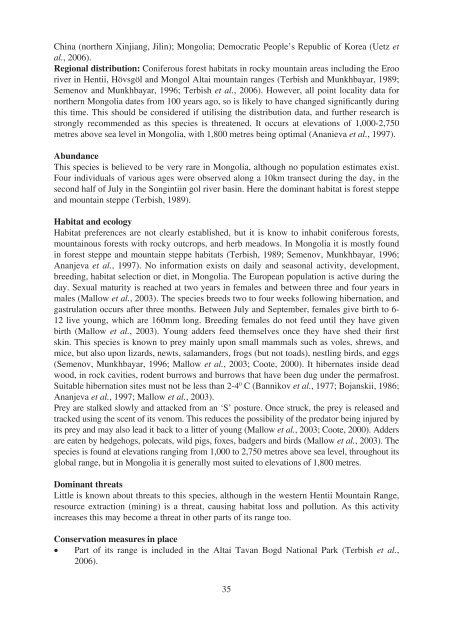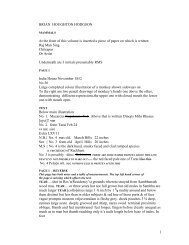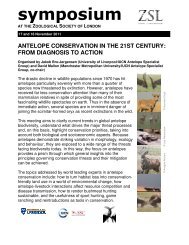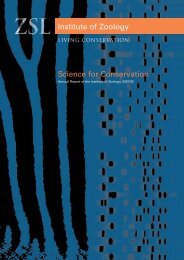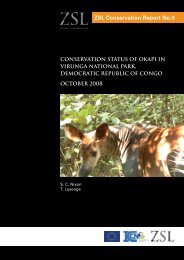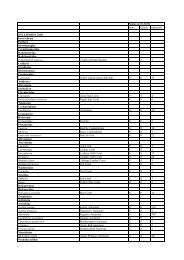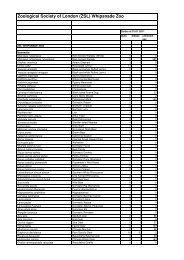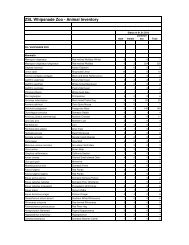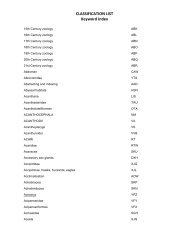Summary Conservation Action Plans for Mongolian Reptiles and ...
Summary Conservation Action Plans for Mongolian Reptiles and ...
Summary Conservation Action Plans for Mongolian Reptiles and ...
You also want an ePaper? Increase the reach of your titles
YUMPU automatically turns print PDFs into web optimized ePapers that Google loves.
China (northern Xinjiang, Jilin); Mongolia; Democratic People’s Republic of Korea (Uetz et<br />
al., 2006).<br />
Regional distribution: Coniferous <strong>for</strong>est habitats in rocky mountain areas including the Eroo<br />
river in Hentii, Hövsgöl <strong>and</strong> Mongol Altai mountain ranges (Terbish <strong>and</strong> Munkhbayar, 1989;<br />
Semenov <strong>and</strong> Munkhbayar, 1996; Terbish et al., 2006). However, all point locality data <strong>for</strong><br />
northern Mongolia dates from 100 years ago, so is likely to have changed signifi cantly during<br />
this time. This should be considered if utilising the distribution data, <strong>and</strong> further research is<br />
strongly recommended as this species is threatened. It occurs at elevations of 1,000-2,750<br />
metres above sea level in Mongolia, with 1,800 metres being optimal (Ananieva et al., 1997).<br />
Abundance<br />
This species is believed to be very rare in Mongolia, although no population estimates exist.<br />
Four individuals of various ages were observed along a 10km transect during the day, in the<br />
second half of July in the Songintiin gol river basin. Here the dominant habitat is <strong>for</strong>est steppe<br />
<strong>and</strong> mountain steppe (Terbish, 1989).<br />
Habitat <strong>and</strong> ecology<br />
Habitat preferences are not clearly established, but it is know to inhabit coniferous <strong>for</strong>ests,<br />
mountainous <strong>for</strong>ests with rocky outcrops, <strong>and</strong> herb meadows. In Mongolia it is mostly found<br />
in <strong>for</strong>est steppe <strong>and</strong> mountain steppe habitats (Terbish, 1989; Semenov, Munkhbayar, 1996;<br />
Ananjeva et al., 1997). No in<strong>for</strong>mation exists on daily <strong>and</strong> seasonal activity, development,<br />
breeding, habitat selection or diet, in Mongolia. The European population is active during the<br />
day. Sexual maturity is reached at two years in females <strong>and</strong> between three <strong>and</strong> four years in<br />
males (Mallow et al., 2003). The species breeds two to four weeks following hibernation, <strong>and</strong><br />
gastrulation occurs after three months. Between July <strong>and</strong> September, females give birth to 6-<br />
12 live young, which are 160mm long. Breeding females do not feed until they have given<br />
birth (Mallow et al., 2003). Young adders feed themselves once they have shed their fi rst<br />
skin. This species is known to prey mainly upon small mammals such as voles, shrews, <strong>and</strong><br />
mice, but also upon lizards, newts, salam<strong>and</strong>ers, frogs (but not toads), nestling birds, <strong>and</strong> eggs<br />
(Semenov, Munkhbayar, 1996; Mallow et al., 2003; Coote, 2000). It hibernates inside dead<br />
wood, in rock cavities, rodent burrows <strong>and</strong> burrows that have been dug under the permafrost.<br />
Suitable hibernation sites must not be less than 2-4 0 C (Bannikov et al., 1977; Bojanskii, 1986;<br />
Ananjeva et al., 1997; Mallow et al., 2003).<br />
Prey are stalked slowly <strong>and</strong> attacked from an ‘S’ posture. Once struck, the prey is released <strong>and</strong><br />
tracked using the scent of its venom. This reduces the possibility of the predator being injured by<br />
its prey <strong>and</strong> may also lead it back to a litter of young (Mallow et al., 2003; Coote, 2000). Adders<br />
are eaten by hedgehogs, polecats, wild pigs, foxes, badgers <strong>and</strong> birds (Mallow et al., 2003). The<br />
species is found at elevations ranging from 1,000 to 2,750 metres above sea level, throughout its<br />
global range, but in Mongolia it is generally most suited to elevations of 1,800 metres.<br />
Dominant threats<br />
Little is known about threats to this species, although in the western Hentii Mountain Range,<br />
resource extraction (mining) is a threat, causing habitat loss <strong>and</strong> pollution. As this activity<br />
increases this may become a threat in other parts of its range too.<br />
<strong>Conservation</strong> measures in place<br />
• Part of its range is included in the Altai Tavan Bogd National Park (Terbish et al.,<br />
2006).<br />
35


